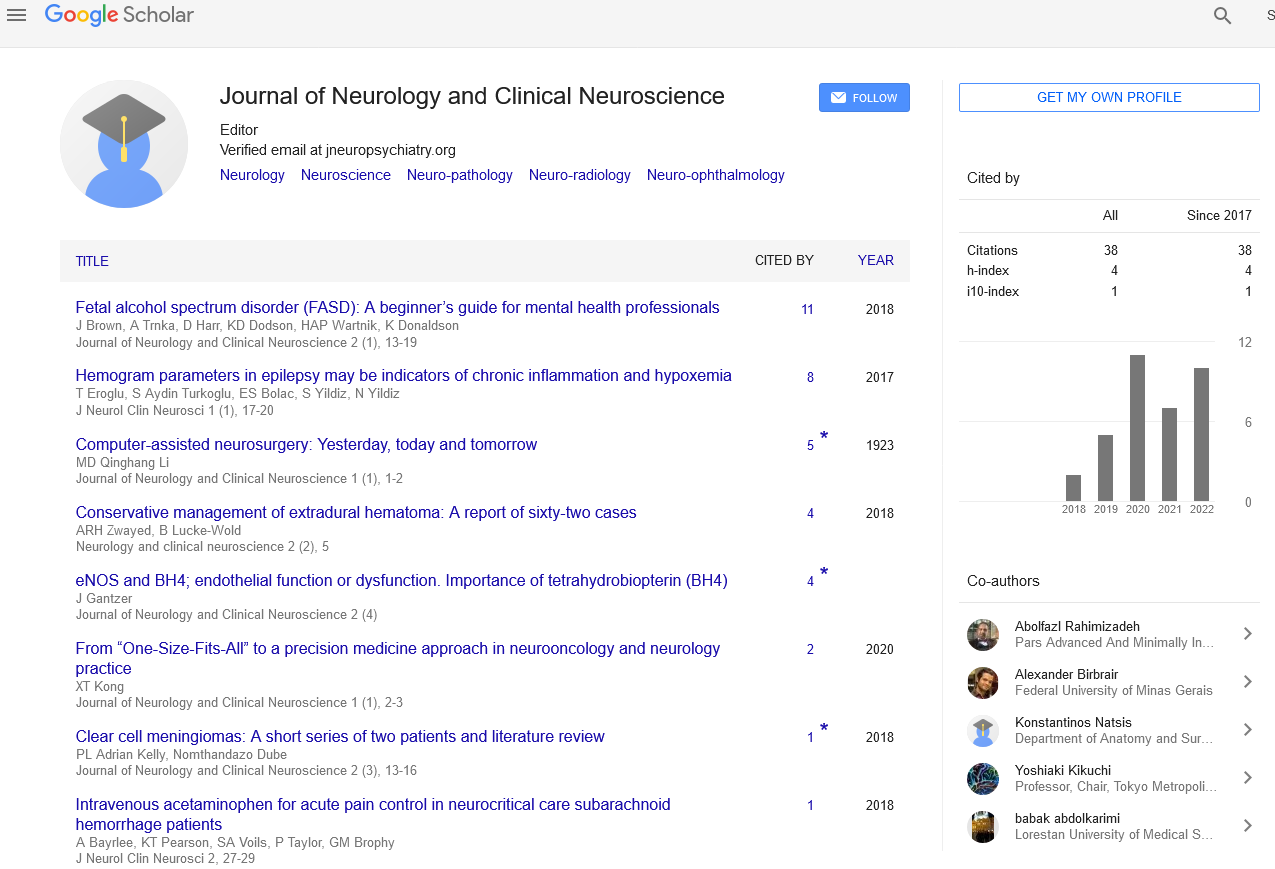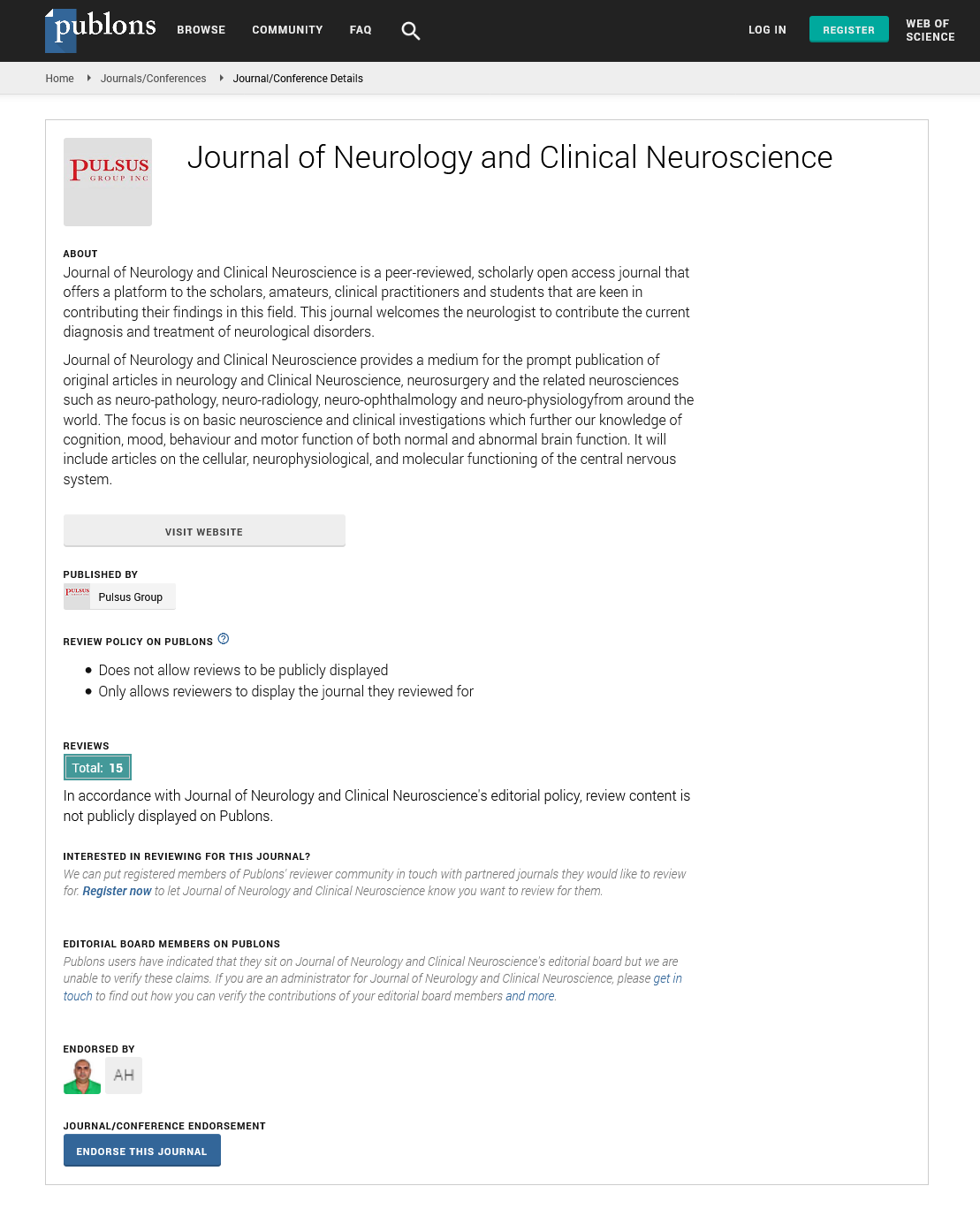To test neuro-regenerative materials, a traumatic brain injury in-vitro model is used
Received: 03-Jan-2023, Manuscript No. PULJNCN-23-6015; Editor assigned: 06-Jan-2023, Pre QC No. PULJNCN-23-6015 (PQ); Reviewed: 20-Jan-2023 QC No. PULJNCN-23-6015; Revised: 21-Mar-2023, Manuscript No. PULJNCN-23-6015 (R); Published: 27-Mar-2023
Citation: Masule LS. To Test Neuro-Regenerative Materials, a Traumatic Brain Injury in-vitro Model is used. J Neurol Clin Neurosci 2023;7(1):1.
This open-access article is distributed under the terms of the Creative Commons Attribution Non-Commercial License (CC BY-NC) (http://creativecommons.org/licenses/by-nc/4.0/), which permits reuse, distribution and reproduction of the article, provided that the original work is properly cited and the reuse is restricted to noncommercial purposes. For commercial reuse, contact reprints@pulsus.com
Abstract
Heart valve repair and replacement is an invasive surgery which may compromise quality of life for the patients concerned. Therefore, patients who had heart valve surgery need rehabilitation interventions to prevent potential complications, and to promote quality of health. A rehabilitation programme is a medically supervised intervention which can assist patients coping with challenges related to heart surgeries and prevent potential complications. This review was undertaken to identify core components of a cardiac rehabilitation programme which can feasibly be adopted for the rehabilitation of patients who had heart valve surgeries locally. A literature review of articles on best practices regarding the core components of cardiac rehabilitation for patients who underwent heart valve repair or replacement surgery was undertaken. Published international guidelines of best practice for cardiac rehabilitation from 1993 to 2018, available in English language were identified through a search of electronic database and reviewed. A total of 20 articles with concepts on cardiac rehabilitation programme were retrieved. Out of the total, only 8 articles meet the criteria and the data were collected from the 8 articles. The findings indicated that patient assessment, exercise, physical counselling, diet/nutritional counselling, tobacco cessation, mental health, return to work, lipids, hypertension, cardio protective therapies are essential components for the rehabilitation after heart valve surgeries, to support patients and their families to cope with challenges related to surgeries. These in return improve quality of life for the patients concerned. The core components for the cardiac rehabilitation programmes as highlighted by the international guidelines can be adapted to the cardiac rehabilitation programme in Namibia if tailored to the contextualized needs for the cardiac patients in Namibia.
Keywords
Cardiac rehabilitation; Core components; Guidelines; Heart valve surgery; Heart valve replacement
Introduction
The 70%–90% of pTBI patients dying before hospital admission and 50% of those who do arrive at the hospital passing away in the emergency room, penetrating TBI (pTBI) has the worst clinical prognosis of all head injury cases. In the USA, pTBI causes 32,000 to 35,000 annual civilian fatalities. PTBI involves a foreign body-created injury track that results in cavitation, nerve fiber compression or shearing, blood vessel rupture and significant loss of neural cells. Debridement of the injury sites is being employed as a kind of treatment, and it may also entail decompressive craniotomies or craniotomies with biomaterials applied to the skin's surface to act as infection barriers and close wounds. These clinical strategies place a strong emphasis on patient monitoring and are supportive. A key gap for regenerative medicine, however, is the lack of clinical medicines that actually improve repair.
Description
After a heart surgery, therefore to improve patients physical function and increase their quality of life. Implantable proregenerative biomaterials (both surgical grade and laboratory grade), which can act as structural supports in damage sites, have showed great promise in preclinical studies. These implants, which can be made of synthetic or natural materials, may help with regeneration processes such stem/precursor cell infiltration, immunomodulation, and decreased glial scarring. One such instance is the surgical dural sealant DuraGen PlusTM, which has been found to support the proliferation of neural cells, including rat cortical neurons, without causing any negative side effects when implanted into the brain. Additionally, DuraGen PlusTM has been demonstrated to enable brain stem cell growth for transplantation applications, with normal cell proliferation and cell genesis potential.
It is anticipated that the creation of a trustworthy high-throughput model to assess biomaterials will be extremely valuable for experimental research. For examining glial (particularly immune cell) reactions to biomaterials, culture methods containing dissociated brain cells lesioned with a straightforward needle scratch have been reported, but they are infrequently used. Our goal was to create a high throughput, technically straightforward, economically viable, and neuropathomimetic experimental system to investigate the implantation of biomaterials. We present an in vitro pTBI model that satisfies these criteria and show its applicability by "implanting" a clinicalgrade biomaterial that is frequently used in neurosurgery procedures.
Conclusion
The brains of CD1 mice (postnatal days 1-3, male and female) were transferred to dissection media (Hank's balanced salt solution, HEPES, 50 U/ml penicillin, and 50 g/ml streptomycin) on ice after the mice were put to death by pentobarbital anaesthesia overdose. Brain cortices were extracted, physically separated by scalpel, softly triturated (30) by Pasteur pipette (without foaming), and then punctured with syringe and needles (23 gauge triturated 3, 21 gauge 3). 70 m and 40 m sieves were used to separate the solution, and the 50 ml tubes were rinsed with either dissection media or Phosphate Buffered Saline (PBS). In growth medium (D10: DMEM supplemented with 10% FBS, 2 mM ultra glutamine, 1 mM sodium pyruvate, 50 U/ml penicillin, and 50 g/ml streptomycin), cells were pelleted (1200 rpm, 5 min). Trypan blue was used to measure the number of viable cells before they were seeded in D10 media, which is DMEM supplemented with 10% foetal bovine serum, 2 mM ultra glutamine, 1 mM sodium pyruvate, 50 U/ml penicillin, and 50 g/ml streptomycin. In 24 well plates (0.83 105 cells/ml, 0.3 ml/well; 1300 cells/cm2) and T175 culture flasks, cells were seeded on Poly-D-Lysine (PDL) coated glass coverslips. The cells were then incubated at 37°C, 5% CO2, 95% humidified air, with 100% medium refresh at 24th, then 50% media changes every 2-3 days.





